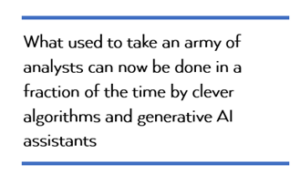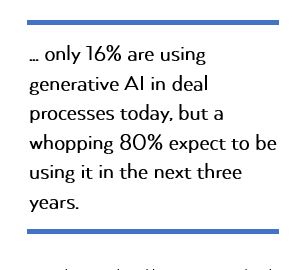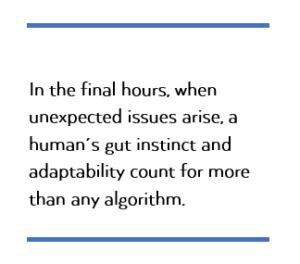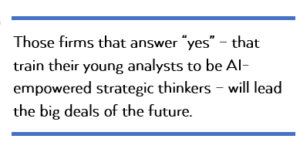Could AI Ever Be an M&A Dealmaker? It’s Already Replacing Their Analysts

 For decades, the baptism-by-fire for young M&A professionals has been long nights of number-crunching and document wrangling. Wall Street’s junior bankers historically cut their teeth on what one Bloomberg piece called the “repetitive, soul-crushing tasks that define junior bankers’ early careers”. These grunt work chores – building financial models till dawn, scouring databases for industry data, collating endless due diligence files – have been seen as a necessary apprenticeship. But today, the rise of AI is poised to rewrite those job descriptions dramatically. As VC legend Marc Andreessen half-joked, AI might replace all jobs except his. In M&A, senior rainmakers may likewise feel secure that closing the final deal over a round of golf will remain a human art. The junior analysts and associates, however, are discovering that AI is already muscling in on the work that once filled their 100-hour weeks.
For decades, the baptism-by-fire for young M&A professionals has been long nights of number-crunching and document wrangling. Wall Street’s junior bankers historically cut their teeth on what one Bloomberg piece called the “repetitive, soul-crushing tasks that define junior bankers’ early careers”. These grunt work chores – building financial models till dawn, scouring databases for industry data, collating endless due diligence files – have been seen as a necessary apprenticeship. But today, the rise of AI is poised to rewrite those job descriptions dramatically. As VC legend Marc Andreessen half-joked, AI might replace all jobs except his. In M&A, senior rainmakers may likewise feel secure that closing the final deal over a round of golf will remain a human art. The junior analysts and associates, however, are discovering that AI is already muscling in on the work that once filled their 100-hour weeks.
Junior analysts and associates traditionally shouldered heavy analytical and administrative tasks at any M&A boutique, investment bank, or corporate development group. These include:
- Financial modelling and valuation – Crunching historical numbers and projecting future performance to assess deal viability. In practice, this means hours in Excel, perfecting revenue forecasts, synergy models, and LBO spreadsheets cell by cell.
- Research and data gathering – Pulling market data, company financials, and industry insights from databases and filings. A first-year analyst might spend days assembling a market map or benchmarking competitors for a pitch.
- Benchmarking and market mapping – Identifying comparable deals or companies, and mapping industry landscapes to position a client’s company.
- Pitch deck and presentation prep – Assembling the PPT decks to pitch clients on deals. This involves copious copying, pasting, formatting, and chart-updating – often at 2 AM before a big meeting.
- Due diligence support – Sifting through data rooms, summarising contracts and financial documents, and preparing due diligence reports for potential targets.
- Administrative coordination – Managing data rooms, scheduling meetings, and liaising with legal or accounting teams.
It’s tedious work and a burden through which junior bankers historically learned the fundamentals. “Putting in the grind” taught them how a model really works, how to spot red flags in a contract, and built the attention to detail and stamina the finance culture demands. Senior bankers often reminisce that this is how they paid their dues, and many juniors have come to appreciate the skills gained by logging through it. However, just because something builds character doesn’t mean it can’t be improved. Enter AI, poised to take the monkey work off human shoulders.
New AI tools are rapidly expanding on the very tasks that have been defined as entry-level M&A jobs. What used to take an army of analysts can now be done in a fraction of the time by clever algorithms and generative AI assistants:
- Generative research and writing – Tools like ChatGPT can draft industry overviews, competitive analyses, or even first cuts of investment memos in seconds. An analyst can prompt a GPT-based assistant to “summarise the cloud software market trends for the past 5 years,” and get a decent narrative that used to require reading dozens of reports. Banks are experimenting with custom GPTs trained on internal deals and market data databases, so an associate can quickly query, say, “Find the EBITDA multiple range for fintech acquisitions in Europe last year” and get instant answers instead of manual research. In fact, major banks are already using AI for tasks such as identifying M&A targets and even automating initial drafts of pitch decks – functions that were entirely in the junior banker’s wheelhouse until now.
- Financial modelling acceleration – Microsoft’s new Excel Copilot and similar AI-driven spreadsheet tools are intelligent co-pilots for number crunchers. They can suggest formulas, auto-generate financial models, and check for calculation errors or anomalies. Instead of laboriously building a 5-year projection model line by line, a junior banker can have Copilot draft a base model structure or instantly spot an inconsistent assumption. This doesn’t eliminate the need for human judgment, but it drastically speeds up the grunt work of modelling. As one review notes, Copilot can even suggest best practices and flag mistakes in a model, acting like a senior mentor looking over the analyst’s shoulder.
- AI-driven document review and due diligence – A huge part of M&A due diligence is reading numerous contracts and documents to spot risks. AI is a perfect fit here. Specialised tools like Kira Systems use machine learning to identify and extract key contract clauses, comparing them against standards. This can slash contract review time by up to 90% in due diligence. Instead of a junior team poring over 500 supplier contracts for change-of-control clauses, an AI can flag the handful that deviate from the norm in minutes. Some boutiques found that early adopters use generative AI to parse the mountain of data in diligence–training models to highlight unusual contract deviations so humans can focus on problematic areas. In other words, the tedious document slog that used to keep junior lawyers and bankers busy is rapidly shrinking.
- Information search and Q&A – AlphaSense, an AI-powered financial search engine, “acts as a virtual analyst at the fingertips of every user” by rapidly scouring filings, transcripts, and research. Rather than manually combing through 10-Ks and equity research for relevant snippets, an analyst can ask AlphaSense or a similar AI, “What were the main risk factors mentioned in Company X’s annual report?” and get an answer with sources in seconds. This accelerates market research and benchmarking dramatically. One industry veteran noted that AI in screening can surface non-obvious acquisition targets that traditional methods might miss – essentially giving junior bankers a brainstorming partner that never sleeps.
- Automated slide generation – Preparing the deal pitch decks and management presentations has long been the bane and badge of junior bankers. Now, AI is tackling that too. FactSet, for example, has introduced a “Pitch Creator” suite of generative AI tools to automate slide-making. It can turn hours of PowerPoint work into minutes by generating charts and tables from data, applying the bank’s branding automatically, and even creating tombstone deal slides with logos at a click. One feature lets analysts type a natural-language prompt to make 90% of the charts needed for a typical pitch deck. Another can pull the latest market data into all slides at once. The upshot: the painstaking “make it perfect” formatting nights might soon be rarer. As FactSet notes, these tools free junior bankers to prioritise high-impact strategic work instead of manually editing graphs.
From drafting emails to populating deal templates, nearly every menial task of an M&A analyst has an AI helper now. Investment banks are investing heavily to weave these tools into workflows. Goldman Sachs reportedly has 1,000 developers working on AI projects internally, and JPMorgan is exploring 400+ AI use cases across the bank. Lazard has even introduced an internal AI chatbot for its bankers, encouraging employees to suggest new use cases for automation. The trend is clear: if there’s a repetitive task, AI will take a crack at it.
As these technologies proliferate, the day-to-day workflow inside deal teams is already changing. Analysts and associates are becoming less like traditional spreadsheet jockeys and more like AI orchestrators, validating and fine-tuning the outputs of various digital assistants. The efficiency gains are significant. Early indicators show that banks can scale up deal capacity by leveraging AI: “the right AI tools will enable junior bankers to complete their core activities materially faster,” allowing them to handle more deals or pitches with the same headcount. Mundane tasks become more manageable, and juniors can redirect time to higher-value work (or maybe even catch a few more hours of sleep).
 Crucially, this isn’t just theory – it’s happening on the ground. A recent Bain & Co. survey of 300 M&A professionals found that only 16% are using generative AI in deal processes today, but a whopping 80% expect to be using it in the next three years. That is a sea change on the immediate horizon. Those early adopters have already seen benefits: 78% reported productivity gains from reduced manual effort, and over half saw faster deal timelines. In practice, what might a mid-2020s M&A process look like? Imagine a leaner deal team where an AI finds viable acquisition targets in a week (what used to take a month of research), drafts a model that an analyst then tweaks and verifies in a day, and even populates a due diligence Q&A database automatically. The junior banker in this scenario becomes a quality-control manager and strategic analyst, double-checking the AI’s work and synthesising the outputs into a coherent deal thesis for the senior bankers and client.
Crucially, this isn’t just theory – it’s happening on the ground. A recent Bain & Co. survey of 300 M&A professionals found that only 16% are using generative AI in deal processes today, but a whopping 80% expect to be using it in the next three years. That is a sea change on the immediate horizon. Those early adopters have already seen benefits: 78% reported productivity gains from reduced manual effort, and over half saw faster deal timelines. In practice, what might a mid-2020s M&A process look like? Imagine a leaner deal team where an AI finds viable acquisition targets in a week (what used to take a month of research), drafts a model that an analyst then tweaks and verifies in a day, and even populates a due diligence Q&A database automatically. The junior banker in this scenario becomes a quality-control manager and strategic analyst, double-checking the AI’s work and synthesising the outputs into a coherent deal thesis for the senior bankers and client.
Another benefit emerging from AI integration is improved accuracy and consistency. Machines don’t get tired at 4 AM – they don’t fat-finger a formula or forget to update slide 37’s footnote. When properly trained, AI tools can minimise human error in data gathering and calculations, delivering more reliable analyses. An analyst can then focus on interpreting the analysis rather than worrying if row 65 in the Excel sheet has an error.
Banks also see a chance to improve junior bankers’ quality of life (and thus retention) by automating the worst grind. If an associate isn’t up all night manually updating charts, they can spend more time with clients or senior mentors or have a more sustainable schedule. That can make the career more attractive to top talent. In a competitive hiring market, firms are touting their AI efficiencies as a selling point – come here, you’ll get to focus on interesting work, not just turn the crank. As one industry commentator noted, AI is a tool for efficiency that frees up time for junior bankers to focus on high-value tasks. The promise is a win-win: better output for the firm and a better experience for the employee.
If AI handles so much of the classical analyst work, what’s left for the humans? In a word: the uniquely human elements of judgment, creativity, and relationship-building. As rote technical skills become less of a differentiator, the skill profile of junior talent is already shifting. An internal memo from one bank’s AI lead suggested efficiency gains of 25-40% for junior bankers, but emphasized this is about role transformation, not elimination. Senior financiers widely agree: the aim is to augment humans, not replace them. That means junior bankers will be evaluated and trained on a new mix of abilities.
Several banks have explicitly started prioritising softer skills in hiring, noting that the traditional focus on brute-force Excel or accounting prowess may give way to things like adaptability, communication, and creativity. “We’re looking for people who know how to interact with AI tools effectively,” one senior banker told Prospect Rock, “not just the ones who can build the fanciest spreadsheet macros”. The junior M&A star of the future might be the one who can ask the right questions of a chatbot, quickly sense-check an AI-generated output against reality, and then craft a compelling narrative for a client.
 Judgment remains paramount. AI can crank out a valuation, but deciding whether those numbers make strategic sense for a client’s situation requires business acumen. It takes nuanced judgment to say, “Yes, the model shows this acquisition pencilling out, but does it align with our client’s long-term strategy and risk appetite?” AI can supply data; humans still provide context and wisdom. In the final hours of a deal, when unexpected issues arise, a human’s gut instinct and adaptability count for more than any algorithm.
Judgment remains paramount. AI can crank out a valuation, but deciding whether those numbers make strategic sense for a client’s situation requires business acumen. It takes nuanced judgment to say, “Yes, the model shows this acquisition pencilling out, but does it align with our client’s long-term strategy and risk appetite?” AI can supply data; humans still provide context and wisdom. In the final hours of a deal, when unexpected issues arise, a human’s gut instinct and adaptability count for more than any algorithm.
Creativity and strategic thinking will also rise in importance. With more bandwidth freed from manual labour, junior professionals can contribute more to brainstorming deal structures, innovative financing solutions, or out-of-the-box targets. An AI might surface fifty logical acquisition targets based on data – it takes human creativity to envision an unconventional partnership or a narrative that turns a “maybe” into a compelling story. As one global CEO might put it, the value is in connecting the dots in ways an AI, focused on past patterns, might not see. M&A often hinges on a creative angle or an insight about the future that isn’t in the databases.
And let’s not forget the interpersonal skills. However advanced technology becomes, M&A is ultimately a people business. Influencing a CEO, negotiating terms between two management teams, or calming a client’s nerves in a volatile market – these are tasks of trust and empathy. Junior bankers who excel in communication and relationship-building will be fast-tracked, as AI takes over the spreadsheets. In essence, the “soft” skills become the hard currency of career advancement. The most successful young dealmakers will be those who can partner with AI for the grunt work while bringing a human touch to interpretation and client interaction. As one observer noted, AI won’t replace investment bankers, but investment bankers who use AI will likely replace those who don’t. The differentiator is using the tools to amplify uniquely human talents.
All these changes spark a crucial question: How do you train the next generation of M&A talent when the apprenticeship model is disrupted? Traditionally, an analyst learned by doing the drudge work under a mentor’s guidance, gradually earning the right to do more complex tasks. If AI shortcuts the drudge work, do young professionals miss out on foundational learning? Many current junior bankers are wary of losing the “training by fire” that grunt work provided. There’s a cultural ethos on Wall Street that cutting your teeth on Excel and due diligence builds skills, humility, and resilience. How do firms preserve the developmental value of that experience in an AI-rich workflow?
One approach is to reimagine the apprenticeship rather than abolish it. As a Bloomberg commentary noted, firms acknowledge there is “something to be said for putting in the grind” and are looking for ways to ensure juniors still build core skills even as AI takes over tasks they once dreaded. Forward-looking dealmakers suggest that junior staff should spend more time interpreting and double-checking AI outputs to learn the underlying logic. Instead of memorizing Excel shortcuts, the new analysts might learn how to sanity-check a machine-generated DCF valuation or how to probe a due diligence AI summary with follow-up questions. It’s a different learning style, similar to a pilot learning to fly with an advanced autopilot. The pilot still learns to fly manually in training, but they also learn to oversee and intervene with the autopilot. Likewise, tomorrow’s bankers must understand the fundamentals (perhaps through simulated exercises or smaller projects done the “old way”) and how to leverage and supervise AI tools. Top firms are already considering structured training modules to teach juniors how to use AI in analysis, alongside case studies of deals that emphasise strategic thinking and client skills.
Crucially, mentorship will evolve. Senior bankers must now teach not just technical finance, but also how to critically evaluate technology-driven analyses. The best mentors will frame AI as a partner – something to be used wisely. As one industry leader commented, “We should reimagine what banking apprenticeship looks like in the digital age. The best mentors will teach juniors to use AI as a tool, not see it as a threat”. In practice, that might mean a VP sits with an analyst to review an AI-drafted model line by line, explaining the reasoning and making adjustments, thus imparting insight in a more interactive way than the old “do it from scratch” method.
Firms also have to manage the cultural shift. The camaraderie built by teams that survive all-nighters pushing deals over the finish line is hard to replicate when an algorithm does a significant portion of the work. Leadership will need to find new ways to challenge juniors and foster team cohesion – perhaps by involving them more in client meetings or assigning tasks that AI cannot handle, such as crafting a novel investment thesis. The hierarchy might flatten somewhat as juniors take on more meaningful responsibilities earlier (since AI handles the grunt prep). This could be energising, but also requires careful oversight to avoid young talent getting in over their heads. It’s a delicate balance: use AI to accelerate development, but don’t let it become a crutch that leaves future bankers ignorant of how things work under the hood.
Interestingly, some in the industry see an upside: accelerated development. If routine work is automated, junior professionals can engage in strategic discussions and client interactions much sooner, potentially growing their judgment and confidence faster than past cohorts. In effect, AI could fast-track the learning of higher-level skills. An analyst might start contributing to creative problem-solving in months rather than spending two years as an “Excel monkey” before getting client exposure. Of course, this only works if they are adequately supported and the fundamentals are still instilled. It falls on leadership to design career paths that leverage AI’s efficiency while still producing well-rounded bankers. As one report put it, the traditional investment banking career path and training model will need to adapt – an already underway evolution in 2025.
The M&A landscape is being reshaped by artificial intelligence at a breathtaking pace. This is exciting and daunting for the new generation of junior dealmakers. Their job descriptions will feature less manual grunt work and far more human judgment and creativity in the coming years. Instead of spending nights tweaking models, they might interpret AI-driven analyses and focus on crafting a deal’s story and strategy. Instead of assembling binders of diligence, they will spend more time distilling insights and advising senior bankers on what truly matters. In short, yesterday’s “hard” work is being offloaded to machines, refocusing human talent on the hard-to-automate work of insight, persuasion, and leadership.
 Companies that master this transition will gain a competitive edge. As Bain’s research suggests, firms that integrate generative AI into M&A will identify targets faster and process more deals than those that don’t. But success won’t just come from having the fanciest algorithms – it will come from cultivating the human capital alongside the AI. The global CEO voice in boardrooms already asks: “Do we have the talent that knows how to use these tools to make smarter deals?” Those firms that answer “yes” – that train their young analysts to be AI-empowered strategic thinkers – will lead the big deals of the future.
Companies that master this transition will gain a competitive edge. As Bain’s research suggests, firms that integrate generative AI into M&A will identify targets faster and process more deals than those that don’t. But success won’t just come from having the fanciest algorithms – it will come from cultivating the human capital alongside the AI. The global CEO voice in boardrooms already asks: “Do we have the talent that knows how to use these tools to make smarter deals?” Those firms that answer “yes” – that train their young analysts to be AI-empowered strategic thinkers – will lead the big deals of the future.
Today’s junior banker is becoming a cyborg: half-human, half-algorithm – and 100% focused on the deal. They have Jarvis from Iron Man in their ear, an army of digital assistants at their command, and therefore the potential to be more effective than any prior generation on Day One. But the human touch remains irreplaceable. The art of M&A has always lived at the intersection of analysis and empathy, numbers and narrative. AI is supercharging the analysis part – crunching the numbers, compiling the facts – yet it’s the narrative and nuanced judgment where the real deal magic happens. As we progress, junior professionals who embrace AI rather than fear it will find it a powerful ally. Those who marry AI-driven efficiency with human creativity and judgment will write the next chapter of M&A success. The grunt work may no longer be a rite of passage, but the next generation will forge their reputation by how well they wield these new intelligent tools.
In conclusion, the junior M&A role is not vanishing – it’s evolving. Much of the hard work may soon be history, but the core mission remains: helping clients navigate complex, high-stakes transactions. AI will handle the heavy lifting of analysis, freeing young bankers to lift their heads up and see the bigger picture. The firms that strike the right balance – leveraging AI for efficiency while developing their people’s strategic and social acumen – will close deals faster and cultivate future leaders who are as comfortable working with algorithms as they are advising a CEO. In the end, the message to every aspiring dealmaker is encouraging: embrace the technology, sharpen your unique human skills, and you’ll thrive in the new M&A era. After all, even the most intelligent AI is just a tool – the humans behind it, armed with judgment and imagination, will make the ultimate decisions that shape industries. And that part of the job description isn’t going away anytime soon.